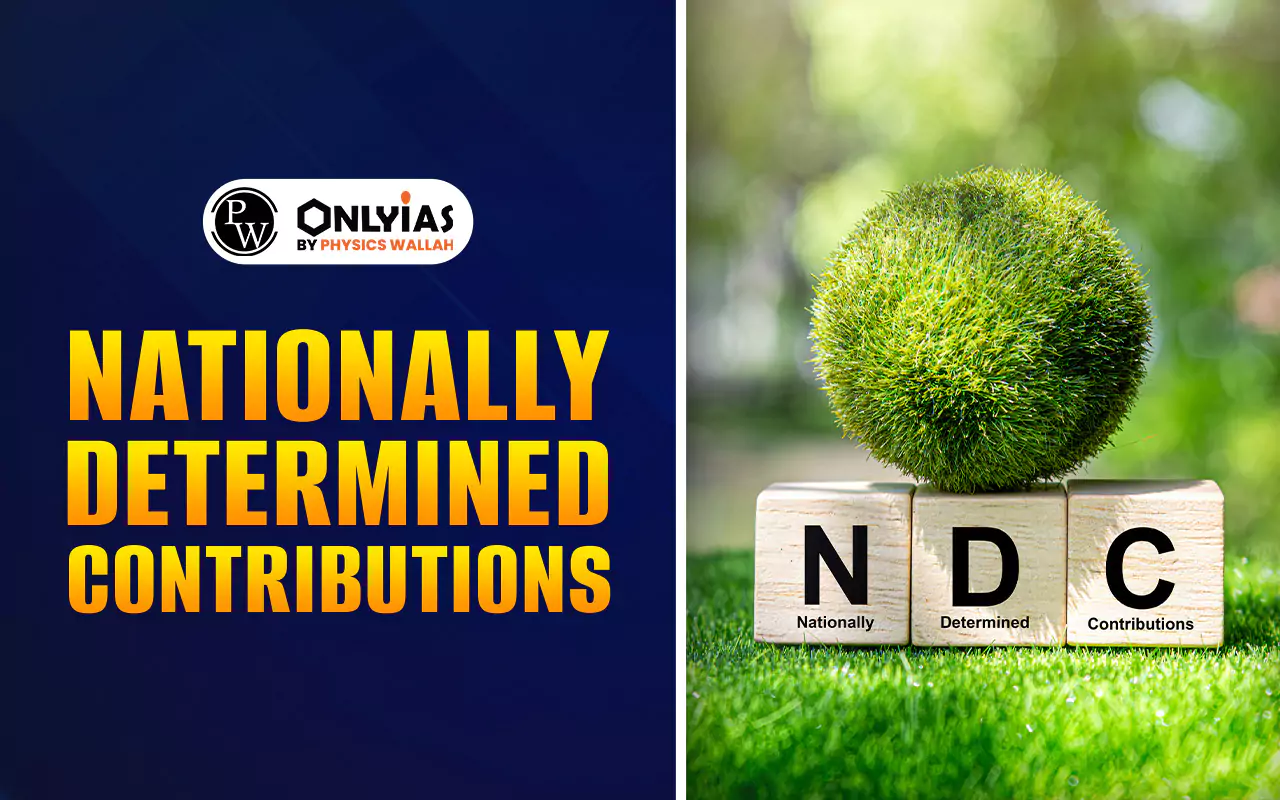Nationally Determined Contributions (NDCs) are climate action plans under the Paris Agreement. Learn NDC meaning, India’s updated 2030 targets, progress on renewables, emission cuts, carbon sinks, and global efforts to fight climate change for a sustainable, low-carbon future.

Nationally Determined Contributions (NDCs) are country-specific climate action plans under the Paris Agreement that outline how nations will reduce emissions and adapt to climate change. Nationally Determined Contributions (NDCs) serve as roadmaps for sustainable growth, clean energy transition, and resilience against climate impacts like floods, droughts, and rising sea levels.
Beyond environmental goals, NDCs also support inclusive development, create green jobs, and improve public health by cutting pollution. For India and the world, NDCs reflect a shared responsibility to fight global warming, achieve low-carbon growth, and build a safer future while ensuring fairness and cooperation among countries.
NDCs full form is Nationally Determined Contributions. These are plans made by every country under the Paris Agreement to fight climate change. Each country in its Nationally Determined Contributions explains its measures. They talk about how they will reduce harmful gases to fight back against global warming.
They also share how they will protect people and nature from problems like rising sea levels, floods, droughts, and heatwaves. Each country must prepare, share, and update its NDCs from time to time. In short, NDCs are promises by countries to work together for a cleaner, safer, and healthier planet for everyone.
It is important to understand that NDC is not only about climate change, but also brings additional benefits. They work like a plan to help a country grow in a clean and green way. Through NDCs, countries can guide industries and workers as they move from using coal and oil to cleaner energy like solar and wind.
They also make sure that more people are included in progress, such as women, young people, and tribal communities. If used well, NDCs can make the economy stronger, create new and better jobs, reduce unfair differences among people, and improve health by reducing pollution.
Nationally Determined Contributions (NDCs) entail within the framework of climate agreements:
In August 2022, India updated its NDCs to UNFCCC, under which India has promised three main targets for 2030:
As of October 2023, 196 countries have communicated their NDCs to the UNFCCC. These NDCs cover 94.9% of global greenhouse gas emissions.
According to the UNFCCC’s NDC Synthesis Report, the total emissions reduction pledged by countries in their NDCs is not enough to limit global warming to 1.5°C.
Here are some of the key findings of the NDC Synthesis Report:
Here are criticisms or challenges are associated with the concept of Nationally Determined Contributions (NDCs) in addressing climate change:
In November 2021, at the 26th Conference of the Parties (COP26) of the UNFCCC held in Glasgow, Prime Minister Narendra Modi unveiled the country’s ambitious climate action plan, known as the ‘Panchamrit’.
In November 2022, India submitted its Long-Term Low-Carbon Development Strategy (LT-LEDS) at the UNFCCC’s COP27 in Egypt’s Sharm el-Sheikh. It is India’s long-term strategy to achieve net-zero emissions by 2070.
India’s LT-LEDS rests on seven key transitions to low-carbon development pathways.
India’s role in contributing to Global Greenhouse Gas Emissions:
Here are challenges to India’s emission reduction efforts:
Here are the initiatives India has undertaken in mitigating climate change:
| National Action Plan on Climate Change (NAPCC) |
|
| The National Adaptation Fund for Climate Change (NAFCC) |
|
| Mission LiFE |
|
| Action plans by States and UTs |
|
| International Coalitions |
|
| International frameworks, conventions, and treaties |
|
Ready to boost your UPSC 2026 preparation? Join PW’s UPSC online courses today!
The full form of NDCs is Nationally Determined Contributions.
Every country under the Paris Agreement prepares and submits NDCs to outline climate actions.
India aims for 45% emission intensity reduction, 50% renewable energy, and 2.5–3 billion tonnes carbon sink.
As of October 2023, 196 countries have submitted their NDCs to the UNFCCC.
India’s long-term goal is to achieve net-zero emissions by 2070.

<div class="new-fform">
</div>